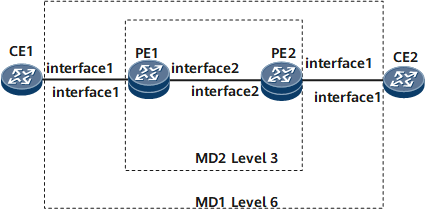Example for Configuring Y.1731 ETH-LCK (BD EVPN)
This section uses typical E2E networking as an example to describe how to use the ETH-LCK function in BD EVPN networking.
Networking Requirements
AIS is used to prevent a MEP in an MD of a higher level from sending the same trap as that sent by a MEP in an MD of a lower level to the NMS. As shown in Figure 1, PE1 and PE2 are connected through an EVPN, and CE1 and CE2 are connected to the EVPN through a BD. Configure the ETH-LCK function for the BD on each PE. A MEP in the inner MD with a lower level initiates out-of-service ETH-test by sending an ETH-LCK frame to a MEP in the outer MD. Upon receipt of the ETH-LCK frame, the MEP in the outer MD suppresses all alarms immediately and reports an ETH-LCK alarm indicating administrative locking. In this way, alarm suppression is implemented.
Configuration Roadmap
- Configure an EVPN between PE1 and PE2.
Add the PEs to an MD, add each PE and its attached CE to an MD, and ensure that the level of the MD to which the PEs belong is lower than that to which each PE and its attached CE belong.
Configure ETH-LCK to suppress MEPs in MDs of different levels from sending the same trap to the NMS.
Data Preparation
To complete the configuration, you need the following data:
EVPN instance name (evpna), RD value, and RT value
BD ID
MD name, MA name, and MEP ID for configuring basic CFM functions
Procedure
- Configure the AC-side link ETH-LCK.
Configure access to an EVPN through a BD.
An EVPN is configured between PE1 and PE2. CE1 and CE2 access the EVPN network through a BD. For details, see the Configuring BD-EVPN Functions or configuration files in this configuration example.
Configure basic Ethernet CFM functions, specify the MEP type as inward, and enable the ETH-LCK function.
Configure basic Ethernet CFM functions on each PE. Specify the Ethernet CFM protocol as IEEE Standard 802.1ag-2007. Create an MD named md1 and an MA named ma1, and bind the MA to the EVPN instance.
[~PE1] cfm enable [*PE1] cfm md md1 level 3 [*PE1-md-md1] ma ma1 [*PE1-md-md1-ma-ma1] map bridge-domain 10 [*PE1-md-md1-ma-ma1] mep mep-id 1 interface gigabitethernet0/1/1.1 vlan 2 inward [*PE1-md-md1-ma-ma1] mep ccm-send mep-id 1 enable [*PE1-md-md1-ma-ma1] mep mep-id 1 lck enable level 6 [*PE1-md-md1-ma-ma1] remote-mep mep-id 2 [*PE1-md-md1-ma-ma1] remote-mep ccm-receive mep-id 2 enable [*PE1-md-md1-ma-ma1] eth-test enable mep 1 [*PE1-md-md1-ma-ma1] commit
The configuration on PE2 is similar to that on PE1. For details, see the 2.
- Configure CE1.
- Configure interfaces and VLANs. For details, see the 3.
Configure basic Ethernet CFM functions on CE1.
[~CE1] cfm enable [*CE1] cfm md md1 level 6 [*CE1-md-md1] ma ma1 [*CE1-md-md1-ma-ma1] map vlan 10 [*CE1-md-md1-ma-ma1] mep mep-id 1 interface gigabitethernet0/1/1 outward [*CE1-md-md1-ma-ma1] mep ccm-send mep-id 1 enable [*CE1-md-md1-ma-ma1] remote-mep mep-id 2 [*CE1-md-md1-ma-ma1] remote-mep ccm-receive mep-id 2 enable [*CE1-md-md1-ma-ma1] commit
The configuration of CE2 is similar to that of CE1. For details, see the 4.
Configuration Files
PE1 configuration file
# sysname PE1 # cfm enable # evpn vpn-instance evpna bd-mode route-distinguisher 100:1 vpn-target 1:1 export-extcommunity vpn-target 1:1 import-extcommunity # mpls lsr-id 1.1.1.1 # mpls # bridge-domain 10 evpn binding vpn-instance evpna # mpls ldp # ipv4-family # interface GigabitEthernet0/1/1 undo shutdown # interface GigabitEthernet0/1/1.1 mode l2 encapsulation dot1q vid 2 rewrite pop single bridge-domain 10 # interface GigabitEthernet0/1/2 undo shutdown ip address 10.1.1.1 255.255.255.0 mpls mpls ldp # interface LoopBack0 ip address 1.1.1.1 255.255.255.255 # bgp 100 peer 2.2.2.2 as-number 100 peer 2.2.2.2 connect-interface LoopBack0 # ipv4-family unicast undo synchronization peer 2.2.2.2 enable # l2vpn-family evpn peer 2.2.2.2 enable # ospf 1 area 0.0.0.0 network 1.1.1.1 0.0.0.0 network 10.1.1.0 0.0.0.255 # evpn source-address 1.1.1.1 # cfm md md1 level 3 ma ma1 map bridge-domain 10 mep mep-id 1 interface GigabitEthernet0/1/1.1 vlan 2 inward mep ccm-send mep-id 1 enable mep mep-id 1 lck enable level 6 remote-mep mep-id 2 remote-mep ccm-receive mep-id 2 enable eth-test enable mep 1 # return
-
# sysname PE2 # cfm enable # evpn vpn-instance evpna route-distinguisher 200:1 vpn-target 1:1 export-extcommunity vpn-target 1:1 import-extcommunity # mpls lsr-id 2.2.2.2 # mpls # bridge-domain 10 evpn binding vpn-instance evpna # mpls ldp # ipv4-family # interface GigabitEthernet0/1/1 undo shutdown # interface GigabitEthernet0/1/1.1 mode l2 encapsulation dot1q vid 2 rewrite pop single bridge-domain 10 # interface GigabitEthernet0/1/2 undo shutdown ip address 10.2.1.1 255.255.255.0 mpls mpls ldp # interface LoopBack0 ip address 2.2.2.2 255.255.255.255 # bgp 100 peer 1.1.1.1 as-number 100 peer 1.1.1.1 connect-interface LoopBack0 # ipv4-family unicast undo synchronization peer 1.1.1.1 enable # l2vpn-family evpn peer 1.1.1.1 enable # ospf 1 area 0.0.0.0 network 2.2.2.2 0.0.0.0 network 10.2.1.0 0.0.0.255 # evpn source-address 2.2.2.2 # cfm md md1 level 3 ma ma1 map bridge-domain 10 mep mep-id 2 interface GigabitEthernet0/1/1.1 vlan 2 inward mep ccm-send mep-id 2 enable mep mep-id 2 lck enable level 6 remote-mep mep-id 1 remote-mep ccm-receive mep-id 1 enable eth-test enable mep 2 # return
-
# sysname CE1 # vlan batch 10 # cfm enable # interface GigabitEthernet0/1/1 portswitch undo shutdown port trunk allow-pass vlan 10 # cfm md md1 level 6 ma ma1 map vlan 10 mep mep-id 1 interface GigabitEthernet0/1/1 outward mep ccm-send mep-id 1 enable remote-mep mep-id 2 remote-mep ccm-receive mep-id 2 enable # return
-
# sysname CE2 # vlan batch 10 # cfm enable # interface GigabitEthernet0/1/1 portswitch undo shutdown port trunk allow-pass vlan 10 # cfm md md1 level 6 ma ma1 map vlan 10 mep mep-id 2 interface GigabitEthernet0/1/1 outward mep ccm-send mep-id 2 enable remote-mep mep-id 1 remote-mep ccm-receive mep-id 1 enable # return

